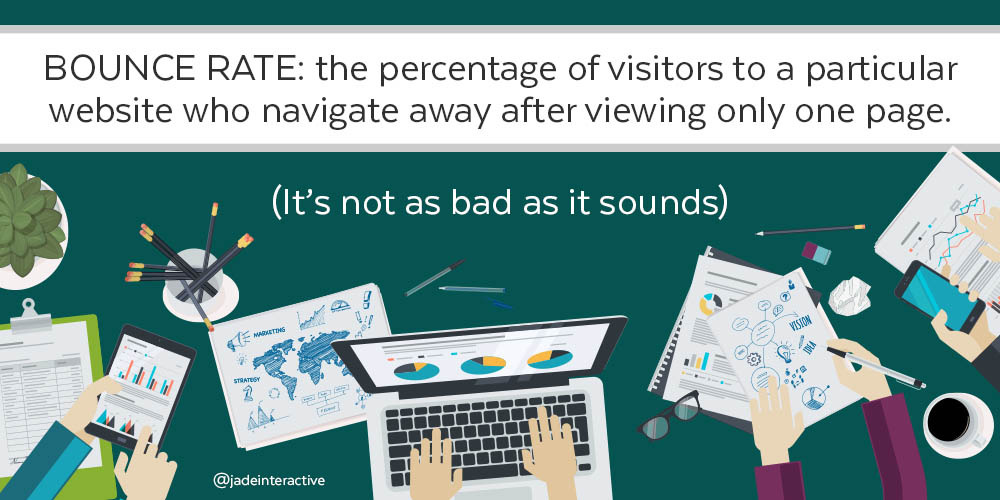You’ve built a new website, spent hours creating the perfect content, carefully selected images, added social links, contact forms, and photo galleries, and set your success expectations sky high … only to be disappointed by lackluster performance. Sound familiar?
What’s the deal with this bounce rate?
First of all, it takes a while to build a solid footprint on the web, so you shouldn’t be disappointed if your analytics paint a dismal picture in the first few months. True, if you’re consistently seeing really high bounce rates in the reports, there may be an issue you need to address … but usually it’s not as bad as it seems. In fact, in certain circumstances, a high bounce rate might actually be a good thing.
[Right at this moment you might be thinking we’re crazy … we’ll admit, that last sentence was a bit of a stretch, but bear with us, we’re getting to the point.]
Need an example?
Let’s say you have a site that provides contact information for local dog walkers. If all your customers want is a phone number for the dog walker closest to their home, and you’ve proudly displayed all their contact info at the top of your homepage,* then no worries! You’ve provided exactly what your visitors needed and there’s no reason to be alarmed that they skipped over the rest of your content.
*Note: if you have a one-page site with nothing but a long list of phone numbers, it’s pretty unlikely anyone will ever find you in a Google search. This probably wasn’t our best example, but regardless, we should chat about your weird, listy homepage. There is definitely room for improvement.
It must be the designer’s fault, right?
For many web marketers (and their clients), bounce rates are a touchy subject – particularly for those who do web design, because when they’re higher-than-expected, it’s assumed to be bad news. A high bounce rate tends to imply that something is inherently wrong with a website that causes visitors to bail before clicking on anything. Some developers will insist the menu navigation is poorly organized, others say the call-to-action elements aren’t compelling enough, and in some cases, the images and copy take the blame … but whatever the root cause, it’s assumed that the website lacks sufficient “stickiness” to keep traffic hanging on and clicking for more. We don’t necessarily agree with those claims. In our experience, a high(ish) bounce rate isn’t always that bad.
-
However, we’ve tested the “let’s blame the designer” theory a number of times on various websites, and usually, we get pretty consistent results:
-
For service-oriented, appointment-only businesses, a big phone number in gigantic letters in the header is really helpful. The bounce rate usually remains high, but the phone at the customer service desk never stops ringing. These sites generally have more traffic from mobile devices too. Coincidence? We don’t think so. Who wants to read a bazillion web pages with tiny font on an iPhone 4, or fumble around with an appointment request form? Honestly, we’d rather just click on a hyperlinked number.
-
On the other hand, wasting valuable homepage real estate to display a phone number doesn’t do much for product-oriented sites (particularly eCommerce websites). The phone rings far less often because website visitors are actively searching for product details that are clearly listed on the product pages. Besides, we would rather use that space to display the latest product offering, coupon code, or to highlight the newest, whiz-bang product feature … those are the elements that keep the bounce rate down. Without them, bounce rates would be off-the-charts, and sales would suffer.
So, to be fair, design does play a part, but it’s by no means THE source of all bounce rate fluctuations. After all, if nobody wants your product, search results are filled with complaints and bad reviews about your company, or your website was built in 2002 (and never updated again), the design won’t make a bit of difference to your site visitors … and you’ve got a much bigger problem than an ugly Google Analytics report!
Don’t freak out!
Our point is that a higher than average bounce rate isn’t freak out-worthy. There may be some issues you should address, but it’s certainly not a disaster. And there are a few key points you should keep in mind when evaluating bounce rate stats:
- They should be evaluated on a page-specific basis … not site-wide.
- They may be caused by referral spam, which has absolutely nothing to do with your site design or content (more on that in another post).
- Conversion rates (phone calls, sales, subscriptions, etc.) are a much better indicator of site performance.
- Average bounce rates are higher than you might expect (+/- 60%).
- Often you can improve “the sticky factor” with just a few simple tweaks to your website.
So unless you have consistently terrible stats for an extended period of time, and literally nothing you do seems to reduce the bounce rate, don’t be too worried! Like everything else on the web, the quality of your site traffic will continue to improve over time. Just stick with it!

